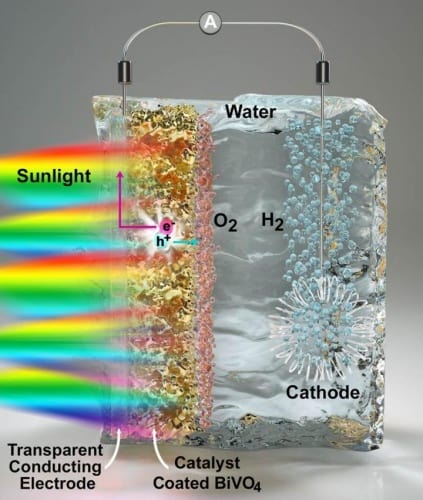Sun-capturing electrodes are designed to absorb as much of the solar spectrum as possible to maximise efficiency. However, they also need to facilitate the easy movement of electrons. Until now, scientists have had to use separate manipulations to increase photon absorption and electron transfer.

The new electrode, described in Nature Communications, is made primarily from the semiconducting compound bismuth vanadate. When the compound was heated to 350 degrees Celsius, the researchers passed nitrogen gas over it, some of which was incorporated into the electrode. This increased the efficiency of both photon absorption and electron transport.
It was found that as well as increasing the transport of electrons by creating ‘defects’ in the bismuth vanadate, the nitrogen also lowered the energy needed to kick electrons into the state in which they were available to split water. This meant that more solar energy could be used by the electrode.
“Now we understand what’s going on at the microscopic level,” said Giulia Galli, a professor at the University of Chicago’s Institute for Molecular Engineering. “So people can use these concepts –incorporation of a new element and new defects into the material – in other systems to try to improve their efficiency. These are very general concepts that could also be applied to other materials.”
Splitting water into its constituent elements has long been touted as a potential source of clean and sustainable energy, with the hydrogen siphoned off to be used as fuel. The researchers hope that their work on the new electrode may act as a building block for other scientists working in the same area.
“Our study will encourage researchers in the field to develop ways to improve multiple processes using a single treatment,” said Kyoung-Shin Choi, a professor of chemistry at the University of Wisconsin. “So it’s not just about achieving higher efficiency, it’s about providing a strategy for the field.”




Report highlights significant impact of manufacturing on UK economy
I am not convinced that the High Value Manufacturing Centres do anything to improve the manufacturing processes - more to help produce products (using...